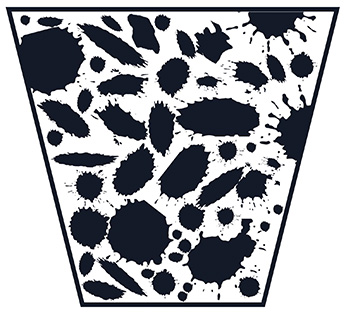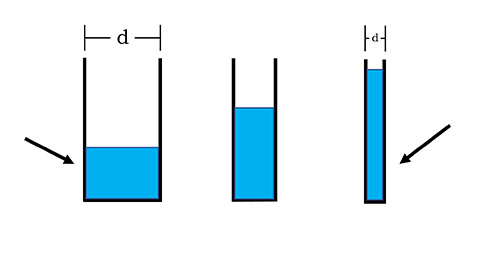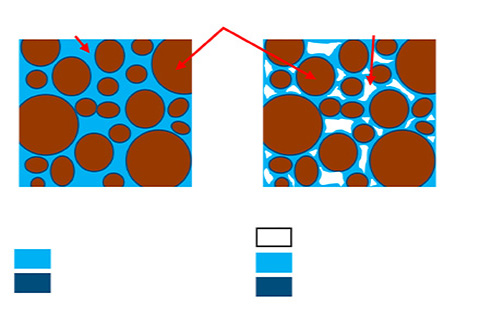5/30/2025
Through the Pores
Jeb S. Fields & Kristopher S. Criscione
When most people evaluate a soilless substrate, they observe the physical nature of the material first. Most will assess how it looks and feels—some of our favorite people even check the smell. These are all important qualities; however, while this is valuable information, the physical structure is just a conduit for the real nature of a substrate.
Let’s try this Rorschach test—you know the abstract inkblots on paper that tell you about your true self? Except this one might help you understand the true nature of a substrate. When you look at Figure 1, what do you see?
What’s the first thing that comes to mind when you look at this image?
 Be honest—did you say peat, bark or another substrate? Most do, but the true nature of a substrate are the pores or the spaces in between the particles. Substrate scientist and pore space expert Bill Fonteno has said on many occasions, “Substrates are spaces.” In fact, a peat-based substrate might be 85% empty volume, while a bark substrate can be 70% pores. Think about that next time you’re buying substrate materials. You’re paying for water and air—a dystopian glimpse into the future. The physical nature of the material makes an interconnected series of channels and voids. These are the pores and this is where all the action occurs. It’s not the substrate particles themselves, but the pores within where components (water, air, fertilizer) and plants interact.
Be honest—did you say peat, bark or another substrate? Most do, but the true nature of a substrate are the pores or the spaces in between the particles. Substrate scientist and pore space expert Bill Fonteno has said on many occasions, “Substrates are spaces.” In fact, a peat-based substrate might be 85% empty volume, while a bark substrate can be 70% pores. Think about that next time you’re buying substrate materials. You’re paying for water and air—a dystopian glimpse into the future. The physical nature of the material makes an interconnected series of channels and voids. These are the pores and this is where all the action occurs. It’s not the substrate particles themselves, but the pores within where components (water, air, fertilizer) and plants interact.
Think of a substrate like a house: the particles are simply structural materials, but all your life occurs within the rooms. Same concept.
Over the next three articles, we’ll explore pore science. In this piece, we’ll take a closer look into substrate porosity, what that really means and how you can harness the power for yourself. At first, these may seem like tough concepts, but hopefully we can shed some light on these ideas and give you a fine-tuned understanding of how the substrate works on a microscale.
Pore Science I: Balancing water & air
As we just learned, substrates are spaces and those spaces are called pores. Every porous material—be it sand, a sponge or a substrate—is a series of interconnected pores. Together, these pores are known as porosity, which is comprised of both water and air—a balance that is continually shifting. As pores are irrigated or plants use water, the space occupied by water and air re-balances, but the total porosity remains constant.
You may have heard of concepts like air-filled porosity (or air space), and water-holding capacity (or container capacity). These are terms we use to evaluate substrate pore structure. Air-filled porosity is the minimum proportion of pore space that can be occupied by air and water-holding capacity is the maximum proportion that can be occupied by water. Remember: the concept of saturation—or 100% of the pore space occupied by water—isn’t achievable in soilless production settings due to free drainage.
Water potential
Water potential makes up the basis for all water movement in and out of pores, as well as through the entire container. Water potential is a tricky concept, but with a little clarity it can be a useful tool. Water tends to take the path of least resistance, so without significant pulling or pushing, most of the movement is downward. Just like an apple falling from a tree, gravity pulls water downward.
With no other forces operating, water would quickly move straight down the container and out the bottom, with little time to be used by the plant. As we know, this doesn’t happen. So what’s going on? The pores themselves are pulling water in all directions and this pull is based on the size of the pore. Smaller pores hold water very tightly and therefore pull water. When the pore is small enough to retain water, that means the force (or tension as we call it) of that pore was great enough to overcome gravity and water is retained. Often, pore tension will pull water laterally, which is how water spreads throughout the container even if it’s applied to a very specific point, like a dripper.
The tension pores exert is called matric potential, and together with gravity, comprises the basis of water potential. Gravity corresponds to the container height. Taller containers will drain more than short containers, even if they’re the same volume. This is from added gravity associated with taller containers. We can adjust gravity by changing the height of the container.
 Differently sized pore diameters will adjust how tightly water is held or allowed to drain.
Differently sized pore diameters will adjust how tightly water is held or allowed to drain.
Matric potential is based on the size of the pores. We use diameter as a rough pore classification—larger pores drain more readily than smaller pores. In reality, there’s no standard pore shape and no true diameter, but it’s a helpful concept. Either way, larger pores exert less tension on water, and pull or retain water less, while smaller pores exert more tension and pull and hold water more tightly. You’ve probably seen a picture of water moving up different sized straws—if not, try putting different diameter straws in a cup of water and watch what happens. You can adjust matric potential by changing particle size. Using finer materials will decrease your pore sizes and increase water tension, while including coarser materials will increase pore size and decrease water tension. This is why we blend coarse materials like bark and perlite in peat substrates to improve drainage.
There are two additional forces that make up water potential: pressure and osmotic potential. When you squeeze a handful of substrate and water comes out, that is pressure potential. We don’t encounter this in production, so we ignore pressure. Osmotic potential involves water moving to neutralize salty conditions. It’s a minor factor in overall water movement, but is worth noting.
Pore & water classification
You may have heard the terms macropores (large pores) or micropores (small pores). Both are helpful to determine water holding. However, a more important classification is the types of water that exist in the pores.
There are three classifications of pores: gravitational, capillary and hygroscopic. Large pores that don’t actually hold water under normal circumstances are called gravitational pores. This is because the pores drain with just the force of gravity. We also call this air space, as these pores are occupied by air under most circumstances.
The smallest pores hold hygroscopic water. These are always full of water in most instances and often this water isn’t available to the plant, as it’s being held so tightly that the plant cannot overcome the tension of the pore. In actuality, hygroscopic water exists in thin films bound to the surface of a particle (or tightly held within very small spaces inside a particle), but it’s easier to understand the concept if you think of these very small pores.
The capillary pores are where all the action takes place with water and air. These pores fill with irrigation and dry with evaporation or plant use (also called evapotranspiration). Capillary pores make up the vast majority of the available water and can be considered the primary action zone within the pore structure.

Water is held by three different types of pores: gravitational, capillary and hygroscopic. Gravitational pores drain immediately, hygroscopic is water not available to plants and capillary pores is where the action takes place.
The container effect
Before we move on, we should discuss why any of this matters. Prior to soilless substrates, growers would fill containers with field soils. These soils have very small particles and therefore small pores. We just learned that small pores hold water very tightly, due to the tension they exert their matric potential. These micropores have such great tension that gravity alone cannot pull water out and the soil stays wet. Why doesn’t this happen in field soils?
Consider the height of a standard container—maybe 6, 8 or 12 in.? That’s not much gravity to pull water down. Soil is deep, providing much greater gravitational force than in a container. This is known as the container effect, where particles need to be large enough to allow gravity to overcome the average pore tension. That is why we use coarse materials like bark, peat, coir and perlite.
Hysteresis
Now we’re getting technical, but this is an important concept. We just learned that pores drain differently—large pores drain readily and smaller pores require greater forces to drain. Since pores are connected, what if a large pore was full and needs to drain through a small pore? Well, once the tension holding water in the small pore is overcome, the water from that pore and the “blocked” large pore will all release. This is known as an ink-bottle effect. Therefore, it took more tension to drain the large pore than should have been required.
Conversely, as water fills the small pore, that larger “blocked” pore will remain empty. This phenomenon is known as hysteresis and in its most basic form is the different ways pores fill between wetting or drying cycles. Why is this important? With each irrigation and drying, the pores are essentially turned on and off. You may not be able to achieve the same moisture levels as time progresses, as pores become blocked and are no longer accessible by water.
Hopefully, you’ve enjoyed this microscopic glimpse into pores and now understand these concepts. Remember: Water potential is how tightly water is held in a pore and that influences all physical balance within the container. We’ll continue this discussion in the next article, with an exploration into everyone’s favorite subject—pore chemistry. GT
Jeb Fields (jsfields@ufl.edu) is a Nursery Specialist with the University of Florida and Editor-at-Large for Nursery & Landscape Insider, a Ball Publishing enewsletter. Kristopher Criscione (kscriscione@vt.edu) is a Nursery Specialist with Virginia Tech University. Together, their work revolves around understanding and improving root zone management in plant production.